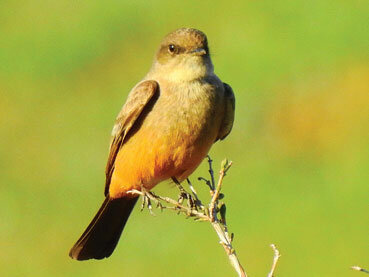
Photo courtesy Charles Martinez
This week’s Bird of the Week, compliments of the Weminuche Audubon Society and Audubon Rockies, is the Say’s phoebe.
In our region, we think of flycatchers as summer birds only, and most of them are, but occurrences of this one are reported in our county in all months except during the dead of winter. These are birds of the western part of North America. They breed farther north than any other flycatcher, ranging in summer from central Mexico to the arctic tundra of Alaska.
Unlike the black phoebe, these phoebes display no affinity for water, instead preferring dry, sparsely vegetated areas and avoiding heavily forested ones. As with most in the flycatcher group, their song is simple, with theirs described as mellow and whistled. Both sexes have gray-brown upperparts and head, a pale orangish belly, and dark tail and wings.
Like most flycatchers and swallows, Say’s phoebes eat almost entirely insects, but they do not limit their diet to aerial ones. In addition to catching prey midair, they also feed by perching on low shrubs or grasses, and by hovering low, while watching for insects and other invertebrates to snatch from the round. This hunting style allows them to find food when airborne insects are scarce.
When choosing a nest site, the most important criteria for these birds is shelter from above. Natural areas include protected ledges on cliffs and rimrock, holes in steep creek banks and abandoned nests of birds like robins and barn swallows. While you will not find them at your seed feeders, you may find them nesting on a ledge under your eaves, or in an open barn or shed. They will return year after year to use a favorite site.
Despite the fact that their use of man-made structures and willingness to nest close to people has allowed Say’s phoebes to live in close proximity, this common bird has not been closely studied and much of its biology remains unknown.
For information on events, visit www.weminucheaudubon.org and www.facebook.com/weminucheaudubon/.